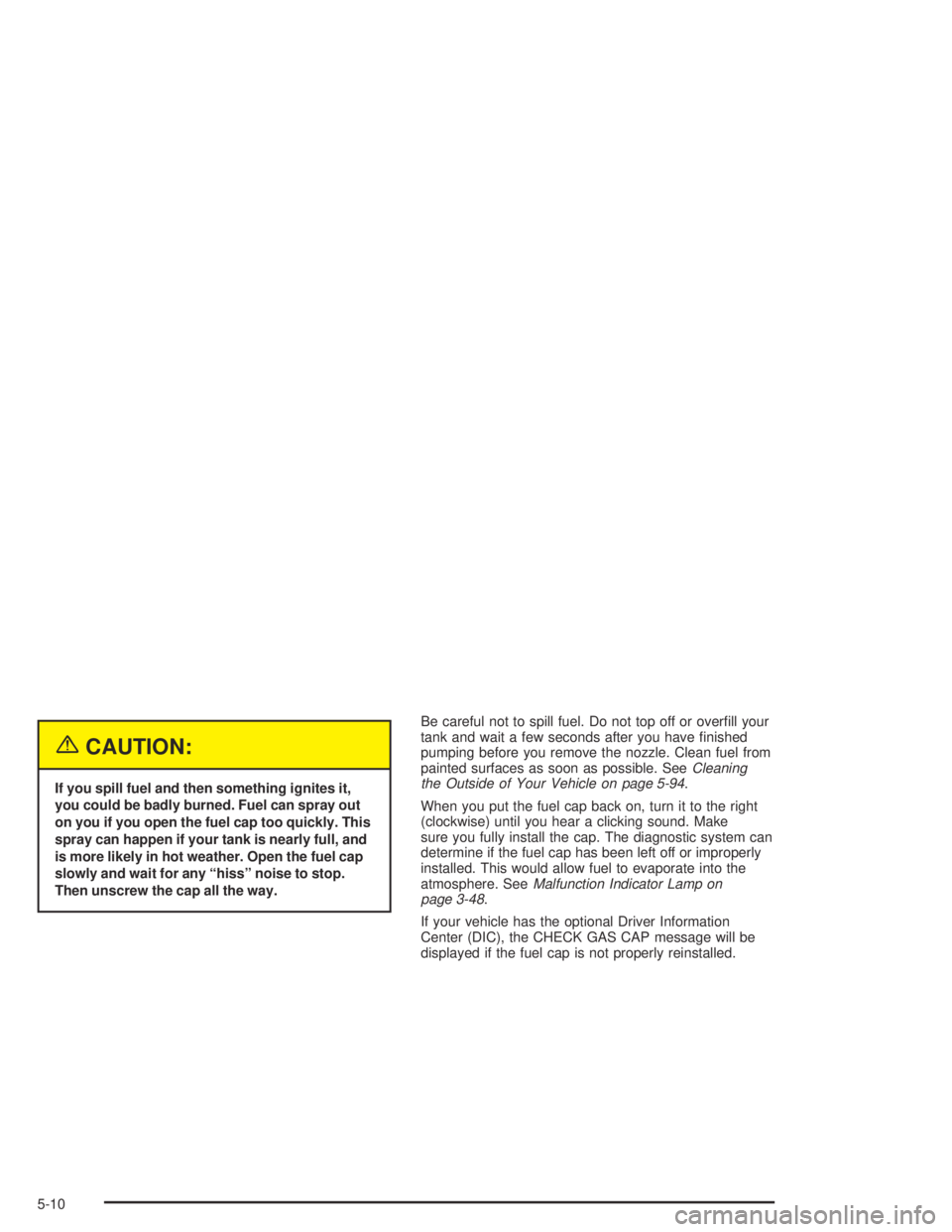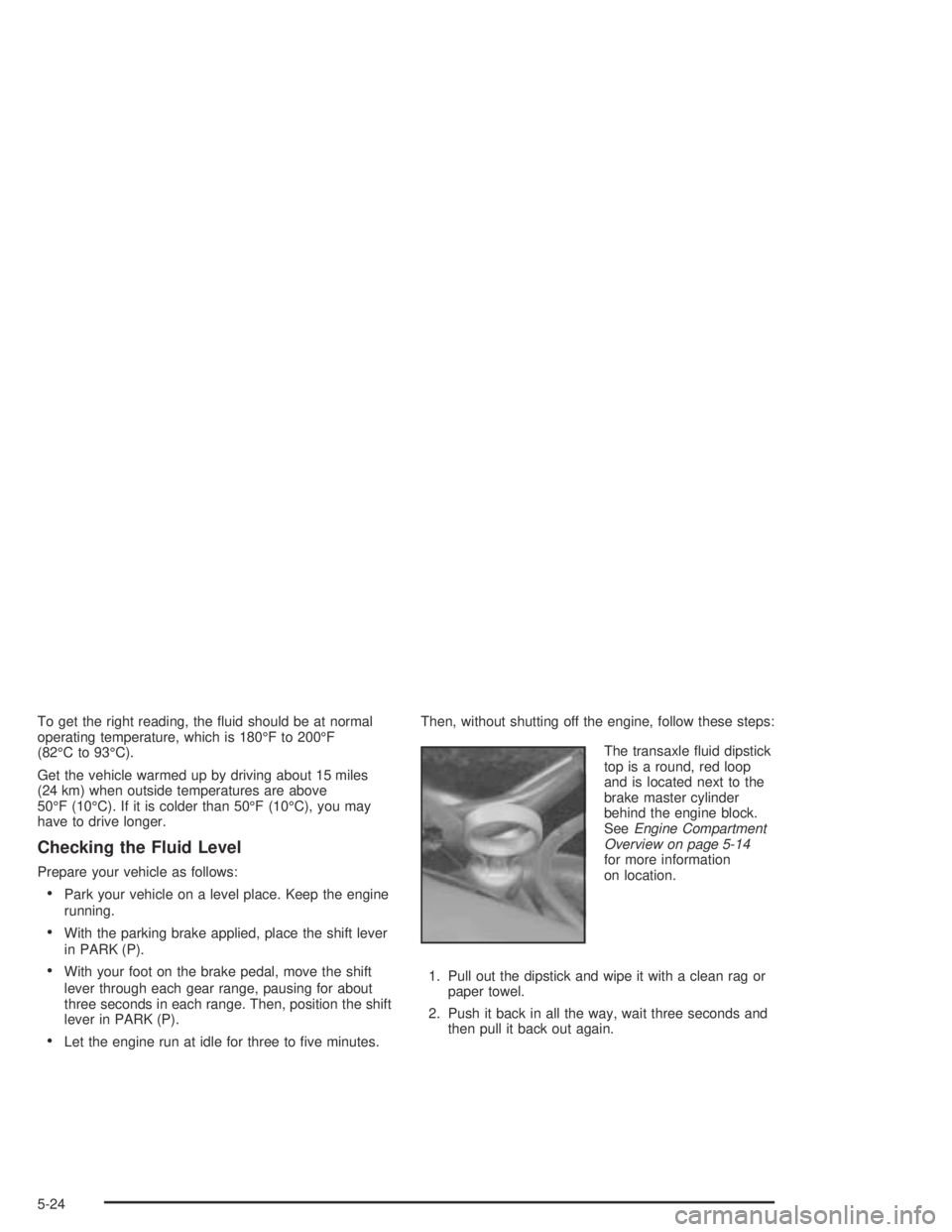Page 286 of 446

{CAUTION:
If you spill fuel and then something ignites it,
you could be badly burned. Fuel can spray out
on you if you open the fuel cap too quickly. This
spray can happen if your tank is nearly full, and
is more likely in hot weather. Open the fuel cap
slowly and wait for any “hiss” noise to stop.
Then unscrew the cap all the way.Be careful not to spill fuel. Do not top off or over�ll your
tank and wait a few seconds after you have �nished
pumping before you remove the nozzle. Clean fuel from
painted surfaces as soon as possible. SeeCleaning
the Outside of Your Vehicle on page 5-94.
When you put the fuel cap back on, turn it to the right
(clockwise) until you hear a clicking sound. Make
sure you fully install the cap. The diagnostic system can
determine if the fuel cap has been left off or improperly
installed. This would allow fuel to evaporate into the
atmosphere. SeeMalfunction Indicator Lamp on
page 3-48.
If your vehicle has the optional Driver Information
Center (DIC), the CHECK GAS CAP message will be
displayed if the fuel cap is not properly reinstalled.
5-10
Page 291 of 446
A. Engine Compartment Fuse Block. See “Engine
Compartment Fuse Block” underFuses and Circuit
Breakers on page 5-101.
B. Windshield Washer Fluid Reservoir. See “Adding
Washer Fluid” underWindshield Washer Fluid
on page 5-40.
C. Engine Coolant Recovery Tank. See “Checking
Coolant” underEngine Coolant on page 5-26.
D. Radiator Pressure Cap. SeeRadiator Pressure Cap
on page 5-28.
E. Power Steering Fluid Reservoir. SeePower Steering
Fluid on page 5-39.F. Engine Oil Dipstick. See “Checking Engine Oil”
underEngine Oil on page 5-16.
G. Engine Oil Fill Cap. See “When to Add Engine Oil”
underEngine Oil on page 5-16.
H. Automatic Transaxle Fluid Dipstick. See “Checking
the Fluid Level” underAutomatic Transaxle Fluid
on page 5-23.
I. Brake Master Cylinder. See “Brake Fluid” under
Brakes on page 5-42.
J. Engine Air Cleaner/Filter. SeeEngine Air
Cleaner/Filter on page 5-21.
5-15
Page 300 of 446

To get the right reading, the �uid should be at normal
operating temperature, which is 180°F to 200°F
(82°C to 93°C).
Get the vehicle warmed up by driving about 15 miles
(24 km) when outside temperatures are above
50°F (10°C). If it is colder than 50°F (10°C), you may
have to drive longer.
Checking the Fluid Level
Prepare your vehicle as follows:
Park your vehicle on a level place. Keep the engine
running.
With the parking brake applied, place the shift lever
in PARK (P).
With your foot on the brake pedal, move the shift
lever through each gear range, pausing for about
three seconds in each range. Then, position the shift
lever in PARK (P).
Let the engine run at idle for three to �ve minutes.Then, without shutting off the engine, follow these steps:
The transaxle �uid dipstick
top is a round, red loop
and is located next to the
brake master cylinder
behind the engine block.
SeeEngine Compartment
Overview on page 5-14
for more information
on location.
1. Pull out the dipstick and wipe it with a clean rag or
paper towel.
2. Push it back in all the way, wait three seconds and
then pull it back out again.
5-24
Page 311 of 446
How to Add Coolant to the Radiator
1. You can remove the radiator pressure cap when
the cooling system, including the radiator pressure
cap and upper radiator hose, is no longer hot.
Turn the pressure cap slowly counterclockwise until
it �rst stops. Do not press down while turning the
pressure cap.
If you hear a hiss, wait for that to stop. A hiss
means there is still some pressure left.
5-35
Page 312 of 446
2. Then keep turning the pressure cap, but now push
down as you turn it. Remove the pressure cap.
3. Remove the 3800 Series II V6 engine cover shield
to access the bleed valve.3.1. Clean the area around the engine oil �ll tube
and cap before removing. Twist the oil �ll
tube, with cap attached, counterclockwise
and remove it.
3.2. Lift the engine cover shield at the front, slide
the catch tab out of the engine bracket and
remove the cover shield.
3.3. Put the oil �ll tube, with cap attached, in the
valve cover oil �ll hole until you are ready to
replace the cover shield.
5-36
Page 313 of 446
4. After the engine cools,
open the coolant air
bleed valve. There
is one bleed valve. It is
located on the
thermostat housing.5. Fill the radiator with the proper DEX-COOL®
coolant mixture, up to the base of the �ller
neck. SeeEngine Coolant on page 5-26for more
information about the proper coolant mixture.
If you see a stream of coolant coming from an air
bleed valve, close the valve. Otherwise, close
the valve after the radiator is �lled.
6. Rinse or wipe any spilled coolant from the engine
and the compartment.
7. Replace the 3800 Series II V6 engine cover shield.
7.1. Remove the oil �ll tube, with cap attached,
from the valve cover.
7.2. Insert the catch tab on the cover shield
under the bracket on the engine.
7.3. Place the hole in the cover shield over the
hole in the valve cover. Install oil �ll tube and
cap by twisting clockwise.
5-37
Page 329 of 446
Headlamps
1. Reach behind the headlamp assembly, push in and
turn the bulb assembly counterclockwise to remove
the bulb assembly from the headlamp assembly.2. Lift the tabs to remove the bulb from the assembly.
3. Replace the bulb. Push the bulb assembly in
and turn it clockwise to install the bulb assembly into
the headlamp assembly.
5-53
Page 331 of 446
4. Tip the headlamp assembly and while pressing the
release, turn the bulb and socket counterclockwise
to remove them.
5. Replace the bulb and reinstall the socket. Then
reconnect the wiring harness to the lamp assembly.6. Slide the lamp assembly back into place by lining
up the track on the bottom of the assembly with
the guide on the vehicle. Then connect the outboard
snap and secure the lamp assembly with the
two bolts.
5-55